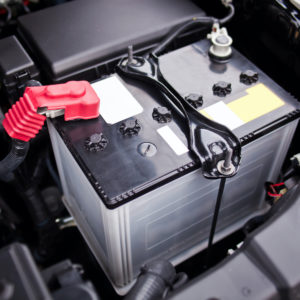
The “starting system”, the heart of the electrical system in your car, begins with the Battery. The key is inserted into the Ignition Switch and then turned to the start position. A small amount of current then passes through the Neutral Safety Switch to a Starter Relay or Starter Selenoid which allows high current to flow through the Battery Cables to the Starter Motor. The starter motor then cranks the engine so that the piston, moving downward, can create a suction that will draw a Fuel/Air mixture into the cylinder, where a spark created by the Ignition System will ignite this mixture. If the Compression in the engine is high enough and all this happens at the right Time, the engine will start.
Battery

The automotive battery, also known as a lead-acid storage battery, is an electrochemical device that produces voltage and delivers current. In an automotive battery we can reverse the electrochemical action, thereby recharging the battery, which will then give us many years of service. The purpose of the battery is to supply current to the starter motor, provide current to the ignition system while cranking, to supply additional current when the demand is higher than the alternator can supply and to act as an electrical reservoir.
The automotive battery requires special handling. The electrolyte (water) inside the battery is a mixture of sulfuric acid and water. Sulfuric acid is very corrosive; if it gets on your skin it should be flushed with water immediately; if it gets in your eyes it should be flushed with a mild solution of baking soda and water immediately and you should see a doctor as soon as possible. Sulfuric acid will eat through clothing, so it is advisable to wear old clothing when handling batteries. It is also advisable to wear goggles and gloves while servicing the battery. When charging, the battery will emit hydrogen gas; it is therefore extremely important to keep flames and sparks away from the battery.
Because batteries emit hydrogen gas while charging, the battery case cannot be completely sealed. Years ago there was a vent cap for each cell and we had to replenish the cells when the electrolyte evaporated. Today’s batteries (maintenance free) have small vents on the side of the battery; the gases emitted have to go through baffles to escape. During this process the liquid condenses and drops back to the bottom of the battery. There’s need to replenish or add water to the battery.
Today’s batteries are rated in cold cranking amps. This represents the current that the battery can produce for 30 seconds at 0 degrees before the battery voltage drops below 7.2 volts. An average battery today will have a CCA (Cold Cranking Amps) of 500. With the many different makes and models of cars available today, batteries will come in many different sizes, but all sizes come in many CCAs. Make sure you get a battery strong enough to operate properly in your car. The length of the warranty is not indicative of the strength of the battery.
Battery cables are large diameter, multistranded wire which carry the high current (250+ amps) necessary to operate the starter motor. Some battery cables will have a smaller wire, soldered to the terminal, which is used to either operate a smaller device or to provide an additional ground. When the smaller cable burns it indicates a high resistance in the heavy cable.
Even maintenance free batteries need periodic inspection and cleaning to insure they stay in good working order. Inspect the battery to see that it is clean and that it is held securely in its carrier. Some corrosion naturally collects around the battery. Electrolyte condensation contains corrosive sulfuric acid, which eats away the metal of battery terminals, cable ends and battery holddown parts. To clean away the corrosion, use a mixture of baking soda and water, and wash all the metal parts around the battery, being careful not to allow any of the mixture to get into the battery (batteries with top cell caps and vents). Rinse with water. Remove the battery cables from the battery (negative cable first), wire brush the inside of the cable end and the battery post. Reinstall the cables (negative end last). Coat all exposed metal parts( paint or grease can be used) so that the sulfuric acid cannot get on the metal.

Ignition Switch
The ignition switch allows the driver to distribute electrical current to where it is needed. There are generally 5 key switch positions that are used:
- Lock – All circuits are open ( no current supplied) and the steering wheel is in the lock position. In some cars, the transmission lever cannot be moved in this position. If the steering wheel is applying pressure to the locking mechanism, the key might be hard to turn. If you do experience this type of condition, try moving the steering wheel to remove the pressure as you turn the key.
- Off – All circuits are open, but the steering wheel can be turned and the key cannot be extracted.
- Run – All circuits, except the starter circuit, are closed (current is allowed to pass through). Current is supplied to all but the starter circuit.
- Start – Power is supplied to the ignition circuit and the starter motor only. That is why the radio stops playing in the start position. This position of the ignition switch is spring loaded so that the starter is not engaged while the engine is running. This position is used momentarily, just to activate the starter.
- Accessory – Power is supplied to all but the ignition and starter circuit. This allows you to play the radio, work the power windows, etc. while the engine is not running.
Most ignition switches are mounted on the steering column. Some switches are actually two separate parts;
- The lock into which you insert the key. This component also contains the mechanism to lock the steering wheel and shifter.
- The switch which contains the actual electrical circuits. It is usually mounted on top of the steering column just behind the dash and is connected to the lock by a linkage or rod.
Neutral Safety Switch
This switch opens (denies current to) the starter circuit when the transmission is in any gear but Neutral or Park on automatic transmissions. This switch is normally connected to the transmission linkage or directly on the transmission. Most cars utilize this same switch to apply current to the back up lights when the transmission is put in reverse. Standard transmission cars will connect this switch to the clutch pedal so that the starter will not engage unless the clutch pedal is depressed. If you find that you have to move the shifter away from park or neutral to get the car to start, it usually means that this switch needs adjustment. If your car has an automatic parking brake release, the neutral safety switch will control that function also.
Starter Relay
A relay is a device that allows a small amount of electrical current to control a large amount of current. An automobile starter uses a large amount of current (250+ amps) to start an engine. If we were to allow that much current to go through the ignition switch, we would not only need a very large switch, but all the wires would have to be the size of battery cables (not very practical). A starter relay is installed in series between the battery and the starter. Some cars use a starter solenoid to accomplish the same purpose of allowing a small amount of current from the ignition switch to control a high current flow from the battery to the starter. The starter solenoid in some cases also mechanically engages the starter gear with the engine.
Battery Cables
Battery cables are large diameter, multistranded wire which carry the high current (250+ amps) necessary to operate the starter motor. Some have a smaller wire soldered to the terminal which is used to either operate a smaller device or to provide an additional ground. When the smaller cable burns, this indicates a high resistance in the heavy cable. Care must be taken to keep the battery cable ends (terminals) clean and tight. Battery cables can be replaced with ones that are slightly larger but never smaller.
Starter Motor
The starter motor is a powerful electric motor, with a small gear (pinion) attached to the end. When activated, the gear is meshed with a larger gear (ring), which is attached to the engine. The starter motor then spins the engine over so that the piston can draw in a fuel/ air mixture, which is then ignited to start the engine. When the engine starts to spin faster than the starter, a device called an overrunning clutch (bendix drive) automatically disengages the starter gear from the engine gear.
Check out this video to know more about how a starter works:
Products Mentioned in this Guide
Any information provided on this Website is for informational purposes only and is not intended to replace consultation with a professional mechanic. The accuracy and timeliness of the information may change from the time of publication.


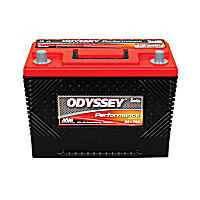 Battery
Battery
 Ignition Switch
Ignition Switch
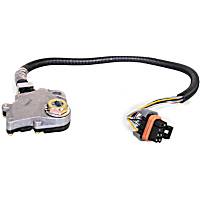 Neutral Safety Switch
Neutral Safety Switch
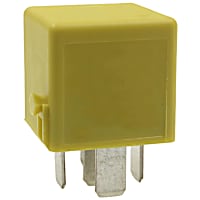 Starter Relay
Starter Relay
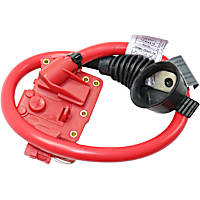 Battery Cable
Battery Cable
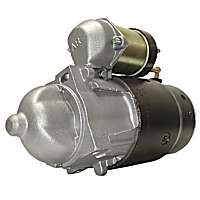 Starter
Starter



